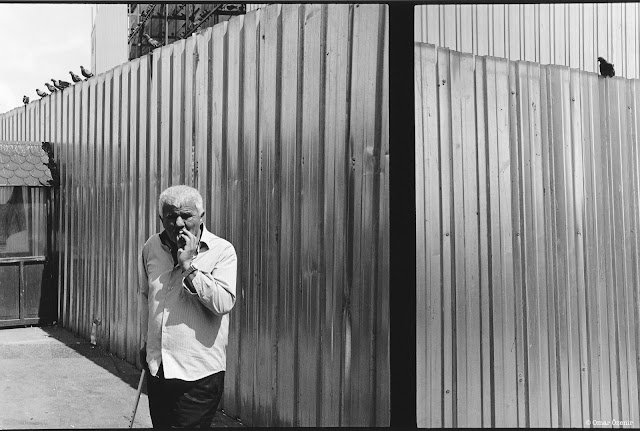Contact sheets might be the best proof that %99 of what we do sucks. Frame after frame it's a hard slap in the face. The vast but unavoidable "waste" to get good pictures is staggering. Yet, they also ruthlessly reveal our shortcomings as photographers, which means they are excellent feedback if we make the effort to listen. We might even see who we really are as a person. "Know thyself" and all that.
But I want to show something with much less gravitas. You might even find it ridiculous. Anyway...the gold mine they are for new "discoveries", whilst going through my contacts for the thousandth time one day last year, I realized that parts of two consecutive frames could work as one picture. An instance where life took a serendipitous turn; where stars mysteriously aligned. After I made a print of that first "discovery" - the top photo - there was no stopping. All of a sudden, I was frantically going through all my contact sheets with a completely different mindset, trying to see a "bigger picture".
 |
| Here I was photographing for a zine where the theme was "Sleep". |
 |
| All prints on Ilford RC Satin paper. |
Needless to say, this is not a novel idea. For example, Gene Smith incorporated part of an adjacent frame into one of his pictures*. Although in that case it wasn't meant to be obvious; he was a journalist after all.
I printed a set of photographs like these and left it at that. Thinking about them now, I feel the end result being completely detached from the photographer's original intent is a problem that can't be simply brushed away. With the word "intent" I mean that which is within the normal photographic frame, i.e. that which the photographer intended to photograph in the first place. So, in the more likely worst case, reframings like these are prone to become a gimmick; but in the best case, I suppose they can become a surrealist's dream.
*Described in an essay by John T. Hill, at the end of the book "W. Eugene Smith - The Camera As Conscience".



Hi Omar - yet again you've covered something, which I think is actually pretty damned original - what a weird, but great idea! I am going to have to dust off the contacts - again I am the same as you - always make one, no matter how terrible the end result is - and have a look with a more critical eye. You could even print MF ones in portrait!
ReplyDeleteI think yours work actually - more please.
There's a John Blakemore interview on You Tube where he says he has recently been producing Japanese-style concertina booklets . . however, some pages in between the photographs contain a window, which totally changes the image - you need to see it to appreciate it - about 9 minutes in:
https://www.youtube.com/watch?v=HBVgetVIXd4
He's still fortunately selling his prints - average around £400 - bit of a bargain for photographic history . . though I have to say it does make me question how hard it must be to try and make a living from this!
Cheers and thanks for a good read again.
Phil
Hi Phil. I love photobooks with non-conventional designs. These tend to strive for some more engagement with the viewer. Foldout pages work really well for example: the viewer has to open and close them (foldouts are pretty mainstream actually). The window idea in the Blakemore video is a very nice touch indeed. It makes the viewer go back and forth and can lead to a deeper appreciation.
DeleteI've always thought Blakemore's photographs have to be enjoyed live, instead of on a screen (or even a book). The richness in tonal nuances in his prints seems to be amazing.
Thanks for your thoughts Phil!
All the best...
My pleasure Omar - I've never made a photobook - maybe I should start. We used to set old type in college all galleys and hot metal - really confusing, but kind of fun.
DeleteBlakemore's Black And White Photography Workshop book (long out of print) is worth hunting down - it is very measured, quite weird at times and packed full of interesting stuff that bears re-reading.
As always, take care!
Years ago, when I was living in London, I used to pop into photo bookshops very often (e.g. The Photographer's Gallery, Zwemmers on Charing Cross Road) and would always come across Blakemore's B&W Photography Workshop and leaf through it, but never doubled down and bought it. My bad.
DeleteI got mine for £8 about 15 years back . . . . sorry about that.
ReplyDelete